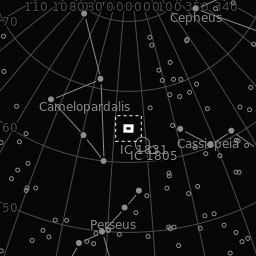
HFG 1
Planetary nebula in the constellation Cassiopeia.

Planetary nebula in the constellation Cassiopeia.
HFG1 was discovered in 1982 by Heckathorn, Fesen and Gull in the Milkyway Emission Line Study. It shows a beautiful shock front, which shines mainly in the OIII-light of doubly ionized oxygen, and a tail-like appearance in the H-alpha-light of hydrogen.
| Object: | HFG 1 and Abell 6 |
| Date of exposures: | 18.09.2020, 19.09.2020, 20.09.2020, 21.09.2020, 22.09.2020 |
| Distance: | 1.500 Lightyears |
| Exposures: | Ha 5nm: 150 x 300", OIII 3nm: 163 x 300", RGB: 122 x 180", Sum: 32.2 hrs. |
| Telescope: | 10'', F4 Newton |
| Focal length: | 1000 mm |
| Filter: | Astrodon E-Series LRGB, H-Alpha 5nm, OIII 3 nm |
| Camera: | ASI 1600 MMC Pro |
| Guiding: | Off Axis Guider, Lodestar |
| Mount: | EQ8 |
HFG1 (PK 136+05) was created with its interesting shape by the star pair V664 Cas. Today one of them is a white dwarf, the second one resembles our sun. Especially interesting is the small distance between these two stars, because they orbit each other within about 14 hours.
Because the binary system V664 Cas moves very fast at 29 to 59 kilometers per second and ploughs through the interstellar medium together with the nebula, a bluish arc shock is produced. In the process, HFG1 leaves behind a long, red trail of gas that is approximately 10,000 years old.
Planetary nebulae have a life span of only about 10,000 years. Very short, considering that sun-like stars live to be about 8-10 billion years old. HFG1 is therefore already very old and will gradually dissolve in space, while the white dwarf will cool and fade for billions of years.